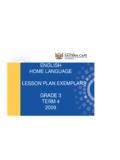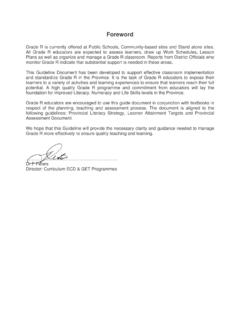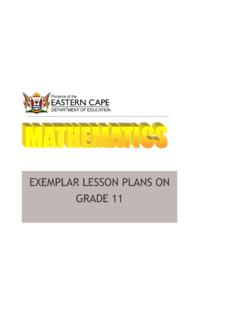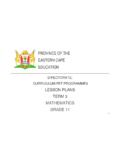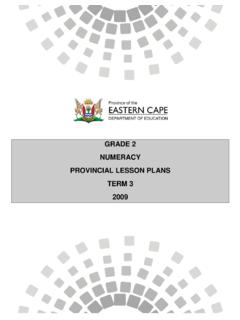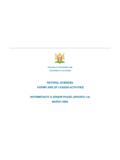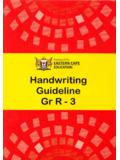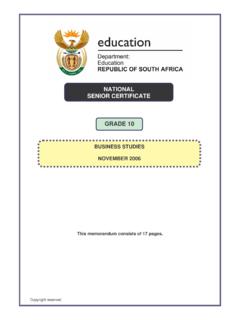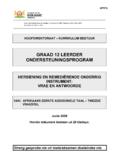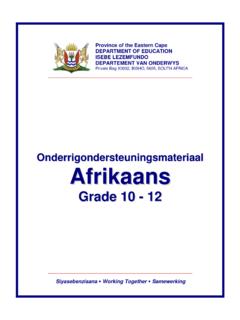Transcription of FIRST ADDITIONAL LANGUAGE LESSON PLAN EXEMPLARS …
1 FIRST ADDITIONALLANGUAGELESSON PLAN EXEMPLARSGRADE 3 TERM 42009 2 Province of the DEPARTMENT OF EDUCATION EASTERN CAPE CURRICULUM SECTION NOTE TO SCHOOL MANAGEMENT TEAMS AND TEACHERS IN THE FOUNDATION PHASE The exemplar Literacy LESSON Plans for grade 1 teachers had been developed by the Provincial and District Foundation Phase Curriculum Advisors and Foundation Phase teachers as well. This is intended to support teachers in the Planning, Teaching and Assessment process for Term 4.
2 The contents include the 3 Learning Programmes (Literacy, Life Skills and Numeracy) in an integrated, flexible and very user friendly manner. The LESSON plans provide specific content and context which should guide the teacher in the planning process. We trust that these support materials will provide the necessary clarity and guidance for teachers to manage the NCS implementation process successfully and confidently. It is the responsibility of the School Management Team to monitor and support teachers in the use of these resources. The teachers are responsible for using these resources to manage the Planning, Teaching and Assessment process successfully in the classroom.
3 These are EXEMPLARS that are aligned to National Policies and prescripts and teachers are encouraged to use and adapt these lessons to suit the needs and context of the learners and the school. If schools need more clarity and guidance on the use of these Resource Materials the District and Provincial Offices can be contacted. We trust that every school will now be better equipped to improve learner performance in the Foundation Phase. Yours in Quality Education ------------------------------------- Dr T Reddy CES: ECD/Foundation Phase: Head Office.
4 Zwelitsha 3 INTRODUCTION The Eastern Cape Department of Education, Curriculum Chief Directorate in collaboration with the District Curriculum Advisors developed this document to support teachers in planning for teaching, learning and assessment for effective implementation of the National Curriculum Statement (NCS) and the Foundations for Learning (FFL) in the Foundation Phase The Home Languages, Afrikaans, English, IsiXhosa and SeSotho deal with the holistic development of the child, socially, emotionally, personally and physically. LANGUAGE is of utmost importance in learners lives.
5 It is the means of communication and conversation. No Learning Area (LA) can be taught without the use of LANGUAGE . So it is necessary for learners to master all aspects of LANGUAGE usage. This includes the ability to talk clearly, fluently and to express themselves without ambiguities; to listen with ease and understanding and to express clearly their thoughts orally and in writing. It also includes the ability to the Listening, Speaking, Reading and Writing in order to enrich their own lives and the lives of others. This document serves to assist teachers to pace teaching, learning and assessment in Afrikaans, English, IsiXhosa and SeSotho Home Languages for Grades 1- 3, starting from grade R in IsiXhosa and English FIRST ADDITIONAL LANGUAGE (FAL) for grade 3.
6 A Work Schedule for term 4 has been developed in Learner Attainment Targets (LAT) documents. Integration of Assessment Standards has been done for the teachers. Planning accommodates Formal Assessment Tasks (FATs) and Learner Attainment Targets (LAT) as indicated in the Afrikaans, English, IsiXhosa, SeSotho Home Languages and FIRST ADDITIONAL LANGUAGE (FAL) LAT documents available in all the Foundation Phase schools. LESSON plan EXEMPLARS can be adapted and refined so that they meet the needs and the context of the learner. The resources that are indicated are a guide.
7 Teachers are at liberty to use other relevant material. The contact time for Literacy Learning Programme is 1 hour 50 minutes daily for grade 1(10mins for FAL), 1hr 50mins for grade 2 (20 mins for FAL) 2hours for grade 3 (30 mins for FAL). 5 hours 15 minutes weekly for the learners and 7 hours weekly for the teachers (1 hr 45 mins for preparations) according to FFL. All the aspects of Literacy have separate time on daily basis, for example Drop All and Read for 30 minutes. This time allocation for Literacy must be adhered to. 4 LITERACY LEARNING PROGRAMME ENGLISH FIRST ADDITIONAL LANGUAGE grade 3: TERM 4: LESSON PLANS THEME: POLLUTION DURATION 1 WEEK TOPIC: INTRODUCTION TO POLLUTION LEARNING OUTCOMES AND ASSESSMENT STANDARDS LEARNING ACTIVITIES LO 2: SPEAKING AS 5: Talks about a picture, photograph or object LO 3: READING AND VIEWING AS : Discusses in own LANGUAGE social and ethical issues ( whether something is fair).
8 AS : Uses word recognition and comprehension skills such as phonics, context clues and prediction to make sense of text. 1. Show learners a picture of a polluted river; it may be the picture of polluted Umtata River obtainable from the department of Water Affairs and Forestry. There are various things and activities captured in the picture that pollute the river, , witchdoctors doing a ritual in the river, people washing clothes in the river, cows and other animals in the river, children swimming in the river, some people defeacating at the banks of the river, ships sailing, people fishing from the river, a refuse dump near the river, litter next to the river, etc.
9 2. The teacher asks learners to look at the picture and (a) Say what they see (b) Predict to make sense of the text by answering questions like, what do you think will happen to plants and animals in the river? What may happen to humans drinking the water? What is likely to happen to children swimming in the river? What will finally happen to the river if the condition continues? (possible answers: All plants and animals may die, Humans may get sick with cholera, the river may no longer promote healthy living, the river may finally dry out (c) Learners discuss in their own LANGUAGE and state whether what is happening to the river is fair and give reasons.)
10 3. Learners use their word recognition skills and use context clues to match labels on flash cards with objects and activities on the picture and paste these appropriately and say 5 LO 4: WRITING AS 5 and 6 Write with and without a frame AS 7: Punctuation LO 5: THINKING AND REASONING AS 1 Comprehension INTEGRATION: Life Orientation- LO 1 AS 1,3,4 Arts and Culture: LO 1 AS 1; 2 what is happening in each case. 4. Learners discuss in pairs what they think they could do to make the river healthy to plants, animals and humans.
